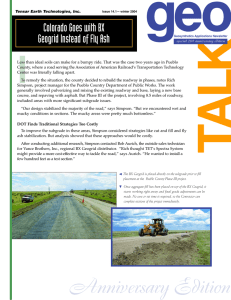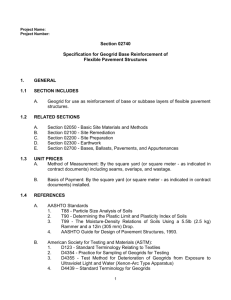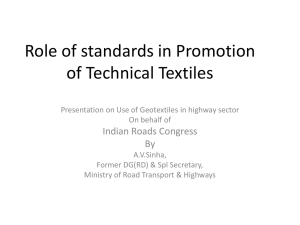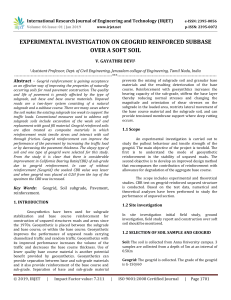use of geogrids in flexible pavement
advertisement
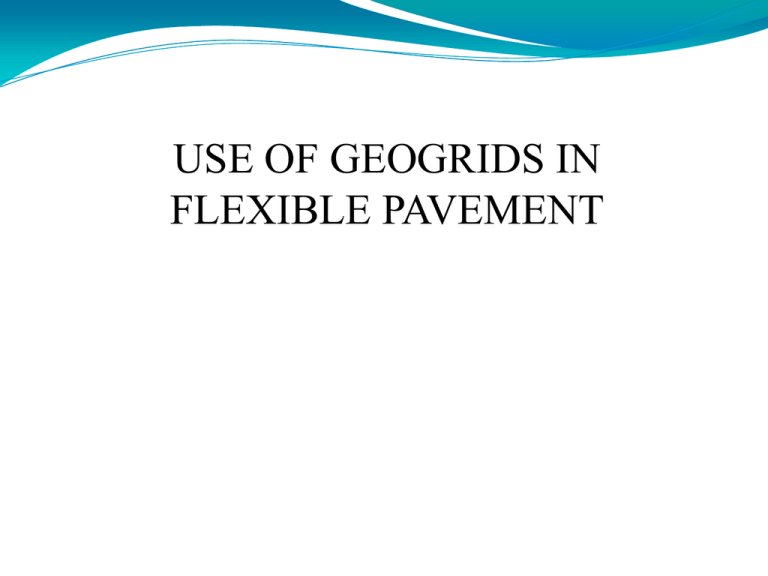
USE OF GEOGRIDS IN FLEXIBLE PAVEMENT GUIDED BY, PRESENTED BY, Prof. K.A.MOHANDAS CHINNU MOL.M ROLL NO 24 S8CA INTRODUCTION • Difficulty in the development and maintenance of pavement with limited financial resources • Unavailability of high quality materials • Geosynthetics- commercial construction aid Separation Reinforcement Filtration Drainage Containment • Geogrid gained increasing acceptance in road construction GEOGRIDS Made from polymers Openings between adjacent longitudinal and transverse ribs called apertures Formed by regular network of integrally connected elements with apertures > ¼” Longitudinal and transverse ribs meet at junctions (nodes) Both rib strength and junction strength are important TYPES WOVEN GEOGRIDS GEOGRID COMPOSITES EXTRUDED GEOGRIDS WELDED GEOGRIDS UNIAXIAL PRE-TENSIONED IN ONE DIRECTION EXTRUDED GEOGRIDS BIAXIAL PRE-TENSIONED IN TWO DIRECTIONS FUNCTIONS Separation Secondary function Reinforcement Primary function Improves engineering properties of pavement system APPLICATIONS Mechanical subgrade stabilization Aggregate base reinforcement Asphalt Concrete (AC) overlay reinforcement USES Construction aid over soft subgrades Improve service life Reduce structural cross-section for given service life REINFORCEMENT MECHANISMS LATERAL RESTRAINT IMPROVED BEARING CAPACITY TENSIONED MEMBRANE EFFECT LATERAL RESTRAINT IMPROVED BEARING CAPACITY TENSIONED MEMBRANE EFFECT MATERIAL PROPERTIES Commonly Reported Engineering Properties of Geogrids Engineering Property Test Method Units 2% or 5% Secant Moduli ASTM D 6637 kN/m Coefficient of Pullout Interaction GRI GG5 - Coefficient of Direct Shear ASTM D 5321 Degrees Aperture Size Direct Measure Mm Percent Open Area COE CW-02215 % Ultimate Tensile Strength ASTM D 6637 kN/m Junction Strength GRI GG2 % Ultraviolet Stability ASTM D 4355 % Minimum Geotextile Specification Requirements Geotextile Property ASTM Test Method Min. Requirement Grab Strength (lb) D 4632 200 Puncture Strength (lb) D 4833 80 Burst Strength (psi) D 3786 250 Trapezoid Tear (lb) D 4533 80 Apparent Opening Size (mm) D 4751 < 0.43 Permittivity (secˉ¹) D 4491 0.05 Ultraviolet Degradation (% Retained Strength @ 500 hr) D 4355 50 Polymer Type - PET or PP AGGREGATE-SURFACED REINFORCED PAVEMENT DESIGN • First step is to determine the properties of subgrade o Grain-size distribution o Atterberg limits o In-situ shear strength Vane shear test CBR test DCP test GEOSYNTHETIC APPLICABILITY FOR SUBGRADES OF DIFFERENT CBR RATIO CBR ≤ 0.5 Nonwoven Geotextile Biaxial Geogrid 0.5 < CBR ≤ 2.0 Reduction in aggregate thickness 2.0 < CBR ≤ 4.0 Geotextile is required for finegrained subgrades CBR > 4.0 Geogrid reinforcement generally considered cost-prohibitive RELATIONSHIP BETWEEN CONE INDEX, CBR AND SHEAR STRENGTH (C) Design Procedure 1. Determination of the Subgrade Shear Strength (C) Directly measured using vane shear devices Converting from CBR to Shear Strength 1. Determination of Design Traffic Based upon the gear configuration of heaviest vehicle expected in the traffic mix Single-wheel Load Dual-wheel Load Tandem-wheel Load The combined weight on the selected gear is used as the design vehicle weight 3. Determination of the Reinforced Bearing Capacity Factor (Nc) The Unreinforced Bearing Capacity Factor = 2.8 The Reinforced Bearing Capacity Factor Recommendations:- GEOTEXTILE GEOGRID BOTH 0.5 < CBR ≤ 2.0 0.5 6.7 6.7 2.0 < CBR ≤ 4.0 0.5 6.7 6.7 CBR VALUE ≤ 0.5 >4.0 4 . Determination of the Required Aggregate Thickness The minimum aggregate thickness is 6 inches Thickness is obtained from Design Curve Subgrade Bearing Capacity (CNc) on X-axis Subgrade Bearing Capacity = Shear Strength x Bearing Capacity Factor Required aggregate thickness on Y-axis CONSTRUCTION OF GEOSYNTHETICREINFORCED PAVEMENTS RECOMMENDED PROCEDURE:- 1. Geotextile Installation 1. Geogrid Installation 1. Aggregate Placement GEOTEXTILE INSTALLATION If CBR < 2.0 vegetation and surface mats should not be removed If CBR ≥ 2.0 subgrade should be compacted stumps, roots, etc. should be removed If CBR > 0.5 geotextile is laid in the direction in which the aggregate will be laid If CBR ≤ 5 geotextile is laid transverse to the direction of the traffic lane Geosynthetic Overlap Requirements For Use Pavements GEOGRID INSTALLATION Site should be cleaned Geogrid should be rolled out by hand directly on subgrade/geotextile for design aggregate thickness < 14 in. For thickness > 14 in. it should be placed in the middle of aggregate layer It can be held in places using staples, pins or sand bags for windy conditions CONCLUSION • The positive effects of geogrid reinforced base courses can economically and ecologically be utilized to reduce reinforced aggregate thickness • The design engineer should be well aware of possible problems and should use this relative new tool for solving them • For this he should understand properties and capabilities of the geogrid materials at hand REFERENCE 1.Christopher, B.R. And Perkins, S.W., 2008. “Full Scale Testing of Geogrids to Evaluate Junction Strength Requirements for Reinforced Roadway Base Design,” Proceedings of the Fourth European Geosynthetics Conference, Edinburgh, United Kingdom, International Geosynthetics Society. 2.Cuelho, E.G. and Perkins, S.W., 2009. Field Investigation of Geosynthetics used for subgrade Stabilization, Summary Report 8193, Montana Department of Transportation, 4 p. (http://www.mdt.mt.gov/research/projects/geotech/subgrade.shtml). 3.Holtz, R.D., Christopher, B.R., and Berg, R.R., 2008. Geosynthetic Design and Construction Guidelines, Participant Notebook, FHWA Publication No. FHWA HI -07092, Federal Highway Administration, Washington, D.C., 592 p. THANK YOU
